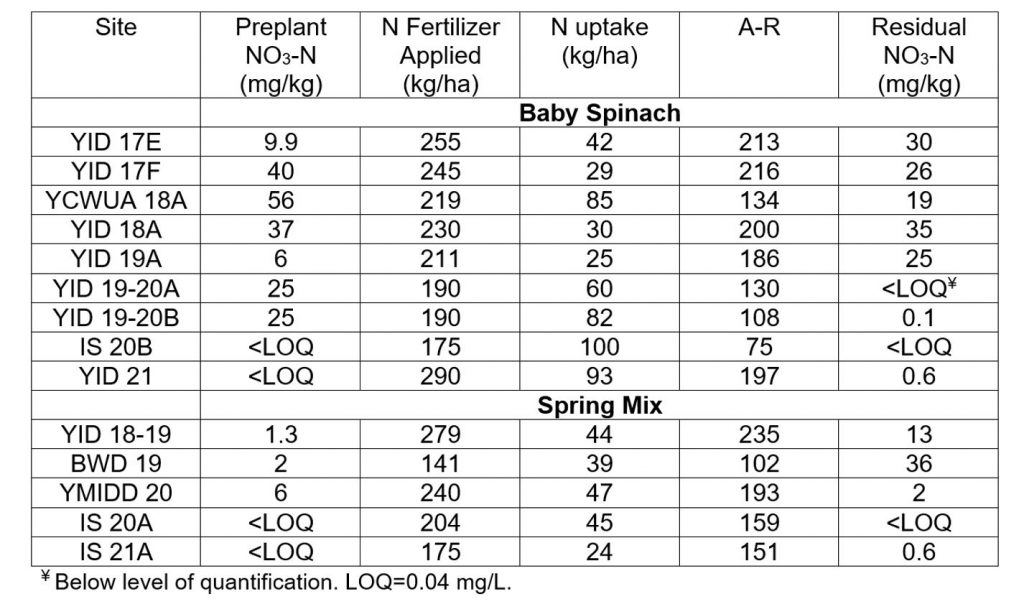Note: This is part of a Research Update series that highlights projects funded by the California Department of Food and Agriculture’s (CDFA) Fertilizer Research and Education Program (FREP) annual grant program.
Project Title: Efficient Water and Nitrogen Management Practices for Mixed Leafy Baby Green Vegetables in the Desert
Project Leaders: Charles A. Sanchez (The University of Arizona); Andrew N French (United States Department of Agriculture, Agricultural Research Service, US Arid-Land Agricultural Research Center)
Project Status: Complete
Overview: This FREP-funded project evaluates various nitrogen (N) and water management practices for mixed baby leafy greens production systems in the Low Desert region.
Background: Over the past decade, the production of high-density mixed leafy green vegetables on large beds (80- and 84-inch beds) has increased. These include various types of mixes for baby lettuce (often called spring mix), baby spinach, and others. Research on the fertilizer requirements for these crops is lacking and many growers have simply utilized the fertilizer practices they currently use on full season lettuce. These crops are grown at a higher density than full season lettuce, and they are harvested early, at 20 to 60 days, compared to the 80- to 150-day full season lettuce crops. Currently, there is no information on how these factors affect irrigation and fertilizer needs. These data gaps for baby leafy greens were of concern since over 35% of the industry has converted to these high-density large bed production systems and this acreage continues to grow. Thus, the objective of this study was to evaluate various N and water management practices for mixed baby leafy greens production systems and calibrate “CropManage” as a management tool for low desert production.
Approach: Researchers employed various techniques and measurement tools in this study to collect data from growers’ farms as well as research sites to achieve the study goals. For example, crop evapotranspiration was measured using an Eddy Covariance system (Figure 1). Irrigation and rainfall inputs were measured with manual and automatic rain gauges. Satellite data were used to process normalized difference vegetation index (NDVI) data streams and salt balance was measured using sensors and data loggers as well as electromagnetic conductance surveys. Final marketable yields were collected for all studies and above-ground plant samples were collected during the season to estimate growth. The researchers conducted N rate studies in small plots at the Maricopa Agricultural Center and used top dress applications of ammonium sulfate and urea, applied before sprinkler irrigation, to simulate fertigation.

Findings: Results from commercial farms showed that the growers often failed to consider the high pre-plant soil nitrate levels in fertilizer decisions. Thus, nitrogen applied (A) was well above the amount of N removed with the harvested crop (R). The fertilizer decisions made also resulted in an A-R well above the targeted 50 kg N/ha being sought by some of the California Water Quality Control Boards (CWQCBs) (Table 1). The high residual inorganic soil N after harvest for several sites supports the conclusion that much of the N applied was not utilized by the crop in-season. Overall, studies conducted in fall 2021, fall-winter 2021, and spring 2022 show baby spinach and spring mix yields were maximized at much lower N rates than previously observed, showing that the evaluated fertigation strategies can reduce N rates, while maintaining maximum yield, and result in an A-R value below the CWQCB targets (Table 2).
Table 1. Summary of preplant soil nitrate, N fertilizer applied, N uptake, A-R, and residual soil nitrate for experiment-demonstration sites.

Table 2. Calculated A-R from fertigation studies conducted in 2021-2022.

Conclusion: Overall, these studies showed that water application efficiencies are generally high in the research sites as well as growers’ fields and poor irrigation management is not the reason for poor N utilization efficiencies. Data collected show that current N fertilizer practices result in N fertilizer rates far exceeding N removal by the crops and high residual inorganic N after harvest. Results from N rate studies showed that baby spinach and spring mix yields were maximized at much lower N rates than previously observed, showing that the efficient fertigation strategies potentially reduced N rates for maximum yield that more consistently match the CWQCB targets. This project has generated a database for continued efficient water management using “CropManage” or other irrigation management models.
To learn more about this project and its findings please visit FREP’s Research and Project Database.
For additional information about CDFA’s FREP-funded projects on research and education regarding the agronomically safe and environmentally sound use of fertilizer in California, please visit: https://www.cdfa.ca.gov/is/ffldrs/frep/CompetitiveGrantProgram.html for more information about the annual FREP Grant Program.
For details about current and completed FREP-funded projects, as well as a searchable database that aims to make the research available, understandable, and convenient for growers to implement, please visit: https://www.cdfa.ca.gov/is/ffldrs/frep/Research.html.


